Recovery of Vanadium (V) Oxyanions by a Magnetic Macroporous Copolymer Nanocomposite Sorbent
Abstract
:1. Introduction
2. Materials and Methods
3. Results
3.1. Structural Characterization
3.2. Vanadium Sorption
4. Discussion
4.1. Effect of pH
4.2. Sorption Isotherms
4.3. Kinetic Models of Sorption
4.4. Quantum Chemical Modeling
5. Conclusions
Author Contributions
Funding
Data Availability Statement
Conflicts of Interest
References
- Luo, X.; Yu, L.; Wang, C.; Yin, X.; Mosa, A.; Lv, J.; Sun, H. Sorption of vanadium (V) onto natural soil colloids under various solution pH and ionic strength conditions. Chemosphere 2017, 169, 609–617. [Google Scholar] [CrossRef]
- Ma, Y.; Wang, X.; Stopic, S.; Wang, M.; Kremer, D.; Wotruba, H.; Friedrich, B. Preparation of Vanadium Oxides from a Vanadium (IV) Strip Liquor Extracted from Vanadium-Bearing Shale Using an Eco-Friendly Method. Metals 2018, 8, 994. [Google Scholar] [CrossRef] [Green Version]
- Li, X.; Wei, C.; Deng, Z.; Li, C.; Fan, G.; Li, M.; Huang, H. Recovery of Vanadium from H2SO4-HF Acidic Leaching Solution of Black Shale by Solvent Extraction and Precipitation. Metals 2016, 6, 63. [Google Scholar] [CrossRef] [Green Version]
- Wang, M.; Huang, S.; Chen, B.; Wang, X. A review of processing technologies for vanadium extraction from stone coal. Miner. Process. Extr. Met. 2018, 129, 290–298. [Google Scholar] [CrossRef]
- Zhang, B.; Gao, Z.; Liu, H.; Wang, W.; Cao, Y. Direct Acid Leaching of Vanadium from Stone Coal. High Temp. Mater. Process. 2016, 36, 877–883. [Google Scholar] [CrossRef] [Green Version]
- Nayl, A.; Aly, H. Solvent extraction of V(V) and Cr(III) from acidic leach liquors of ilmenite using Aliquat 336. Trans. Nonferrous Met. Soc. China 2015, 25, 4183–4191. [Google Scholar] [CrossRef]
- Suručić, L.T.; Nastasović, A.B.; Onjia, A.E.; Janjić, G.V.; Rakić, A.A. Design of an amino-functionalized chelating macroporous copolymer poly(GMA-co-EGDMA) for the sorption of Cu(II) ions. J. Serb. Chem. Soc. 2019, 84, 1391–1404. [Google Scholar] [CrossRef] [Green Version]
- Suručić, L.T.; Janjić, G.; Rakić, A.A.; Nastasovic, A.; Popović, A.R.; Milčić, M.K.; Onjia, A.E. Theoretical modeling of sorption of metal ions on amino-functionalized macroporous copolymer in aqueous solution. J. Mol. Model. 2019, 25, 177. [Google Scholar] [CrossRef]
- Grochowicz, M.; Pączkowski, P.; Gawdzik, B. Investigation of the thermal properties of glycidyl methacrylate–ethylene glycol dimethacrylate copolymeric microspheres modified by Diels–Alder reaction. J. Therm. Anal. Calorim. 2017, 133, 499–508. [Google Scholar] [CrossRef] [Green Version]
- Nastasovic, A.; Onjia, A.; Milonjic, S.; Jovanović, S. Surface characterization of macroporous glycidyl methacrylate based copolymers by inverse gas chromatography. Eur. Polym. J. 2005, 41, 1234–1242. [Google Scholar] [CrossRef]
- Gupta, S.; Ranjit, R.; Mitra, C.; Raychaudhuri, P.; Pinto, R. Enhanced room-temperature magnetoresistance in La0.7Sr0.3MnO3-glass composites. Appl. Phys. Lett. 2001, 78, 362–364. [Google Scholar] [CrossRef]
- Kango, S.; Kalia, S.; Celli, A.; Njuguna, J.; Habibi, Y.; Kumar, R. Surface modification of inorganic nanoparticles for development of organic–inorganic nanocomposites—A review. Prog. Polym. Sci. 2013, 38, 1232–1261. [Google Scholar] [CrossRef]
- Marković, B.M.; Spasojević, V.V.; Dapcevic, A.; Vuković, Z.M.; Pavlović, V.B.; Ranđelović, D.V.; Nastasović, A.B. Characterization of glycidyl methacrylate based magnetic nanocomposites. Chem. Ind. 2019, 73, 25–35. [Google Scholar] [CrossRef] [Green Version]
- Castro, L.; Ayala, L.A.; Vardanyan, A.; Zhang, R.; Muñoz, J.Á. Arsenate and Arsenite Sorption Using Biogenic Iron Compounds: Treatment of Real Polluted Waters in Batch and Continuous Systems. Metals 2021, 11, 1608. [Google Scholar] [CrossRef]
- Araújo, C.S.; Almeida, I.L.; Rezende, H.C.; Marcionilio, S.M.; Leon, J.J.L.; de Matos, T.N. Elucidation of mechanism involved in adsorption of Pb(II) onto lobeira fruit (Solanum lycocarpum) using Langmuir, Freundlich and Temkin isotherms. Microchem. J. 2018, 137, 348–354. [Google Scholar] [CrossRef]
- Webb, P.A.; Orr, C.; Corporation, M.I. Analytical Methods in Fine Particle Technology; Micromeritics Instrument Corporation: Norcross, GA, USA, 1997. [Google Scholar]
- Marković, B.M.; Vuković, Z.M.; Spasojevic, V.; Kusigerski, V.; Pavlović, V.; Onjia, A.; Nastasović, A.B. Selective magnetic GMA based potential sorbents for molybdenum and rhenium sorption. J. Alloys Compd. 2017, 705, 38–50. [Google Scholar] [CrossRef] [Green Version]
- Maciejewska, M. Thermal properties of TRIM–GMA copolymers with pendant amine groups. J. Therm. Anal. Calorim. 2016, 126, 1777–1785. [Google Scholar] [CrossRef] [Green Version]
- Cascaval, C.; Poinescu, I. Thermal characterization of some cross-linked methacrylic adsorbents. Polym. Degrad. Stab. 1995, 48, 55–60. [Google Scholar] [CrossRef]
- Paredes, B.; González, S.; Rendueles, M.; Villa-García, M.A.; Díaz, M. Influence of the amination conditions on the textural properties and chromatographic behaviour of amino-functionalized glycidyl methacrylate-based particulate supports. Acta Mater. 2003, 51, 6189–6198. [Google Scholar] [CrossRef]
- Qiao, B.; Wang, T.-J.; Gao, H.; Jin, Y. High density silanization of nano-silica particles using γ-aminopropyltriethoxysilane (APTES). Appl. Surf. Sci. 2015, 351, 646–654. [Google Scholar] [CrossRef]
- Dugas, V.; Chevalier, Y. Surface hydroxylation and silane grafting on fumed and thermal silica. J. Colloid Interface Sci. 2003, 264, 354–361. [Google Scholar] [CrossRef]
- Huang, J.-H.; Huang, F.; Evans, L.; Glasauer, S. Vanadium: Global (bio)geochemistry. Chem. Geol. 2015, 417, 68–89. [Google Scholar] [CrossRef]
- Agashe, K.B.; Regalbuto, J.R. A Revised Physical Theory for Adsorption of Metal Complexes at Oxide Surfaces. J. Colloid Interface Sci. 1997, 185, 174–189. [Google Scholar] [CrossRef] [PubMed]
- Perrin, D.D. Ionisation Constants of Inorganic Acids and Bases in Aqueous Solution; Pergamon Press Ltd.: Oxford, UK, 1982. [Google Scholar]
- Zhang, L.; Liu, X.; Xia, W.; Zhang, W. Preparation and characterization of chitosan-zirconium(IV) composite for adsorption of vanadium(V). Int. J. Biol. Macromol. 2013, 64, 155–161. [Google Scholar] [CrossRef] [PubMed]
- Pennesi, C.; Totti, C.; Beolchini, F. Removal of Vanadium(III) and Molybdenum(V) from Wastewater Using Posidonia oceanica (Tracheophyta) Biomass. PLoS ONE 2013, 8, e76870. [Google Scholar] [CrossRef] [PubMed] [Green Version]
- Ekmeščić, B.M.; Maksin, D.D.; Markovic, J.P.; Vuković, Z.M.; Hercigonja, R.V.; Nastasović, A.B.; Onjia, A.E. Recovery of molybdenum oxyanions using macroporous copolymer grafted with diethylenetriamine. Arab. J. Chem. 2019, 12, 3628–3638. [Google Scholar] [CrossRef] [Green Version]
- Marjanovic, V.; Peric-Grujic, A.; Ristic, M.; Marinkovic, A.; Markovic, R.; Onjia, A.; Sljivic-Ivanovic, M. Selenate Adsorption from Water Using the Hydrous Iron Oxide-Impregnated Hybrid Polymer. Metals 2020, 10, 1630. [Google Scholar] [CrossRef]
- Hercigonja, R.V.; Maksin, D.D.; Nastasović, A.B.; Trifunović, S.S.; Glodić, P.B.; Onjia, A.E. Adsorptive removal of technetium-99 using macroporous poly(GMA-co-EGDMA) modified with diethylene triamine. J. Appl. Polym. Sci. 2011, 123, 1273–1282. [Google Scholar] [CrossRef]
- Weidner, E.; Ciesielczyk, F. Removal of Hazardous Oxyanions from the Environment Using Metal-Oxide-Based Materials. Materials 2019, 12, 927. [Google Scholar] [CrossRef] [Green Version]
- Foo, K.Y.; Hameed, B.H. Insights into the modeling of adsorption isotherm systems. Chem. Eng. J. 2010, 156, 2–10. [Google Scholar] [CrossRef]
- Dongil, A.B.; Bachiller-Baeza, B.; Guerrero-Ruiz, A.; Rodríguez-Ramos, I.; Martínez-Alonso, A.; Tascón, J.M.D. Surface chemical modifications induced on high surface area graphite and carbon nanofibers using different oxidation and functionalization treatments. J. Colloid Interface Sci. 2011, 355, 179–189. [Google Scholar] [CrossRef] [PubMed]
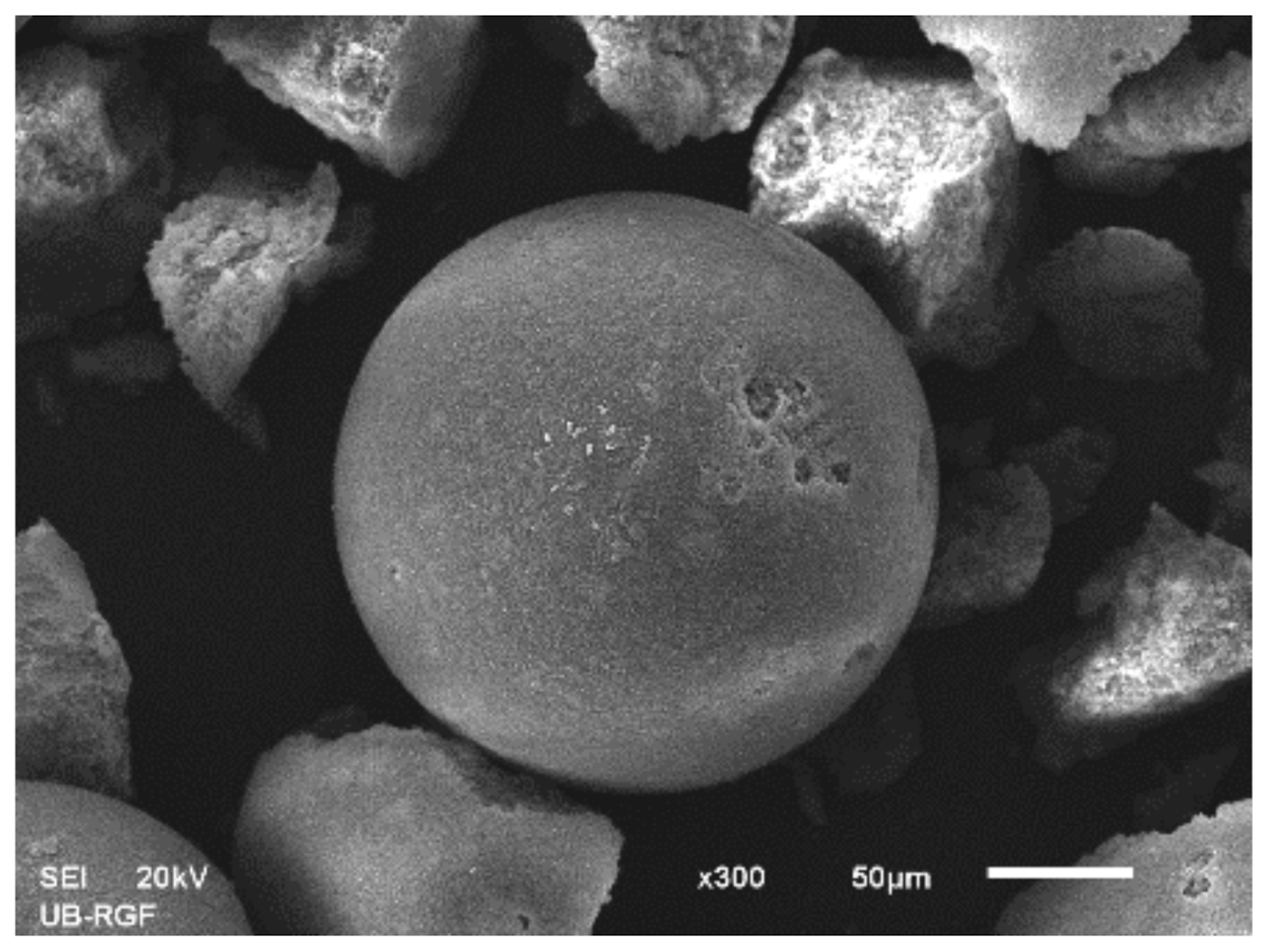

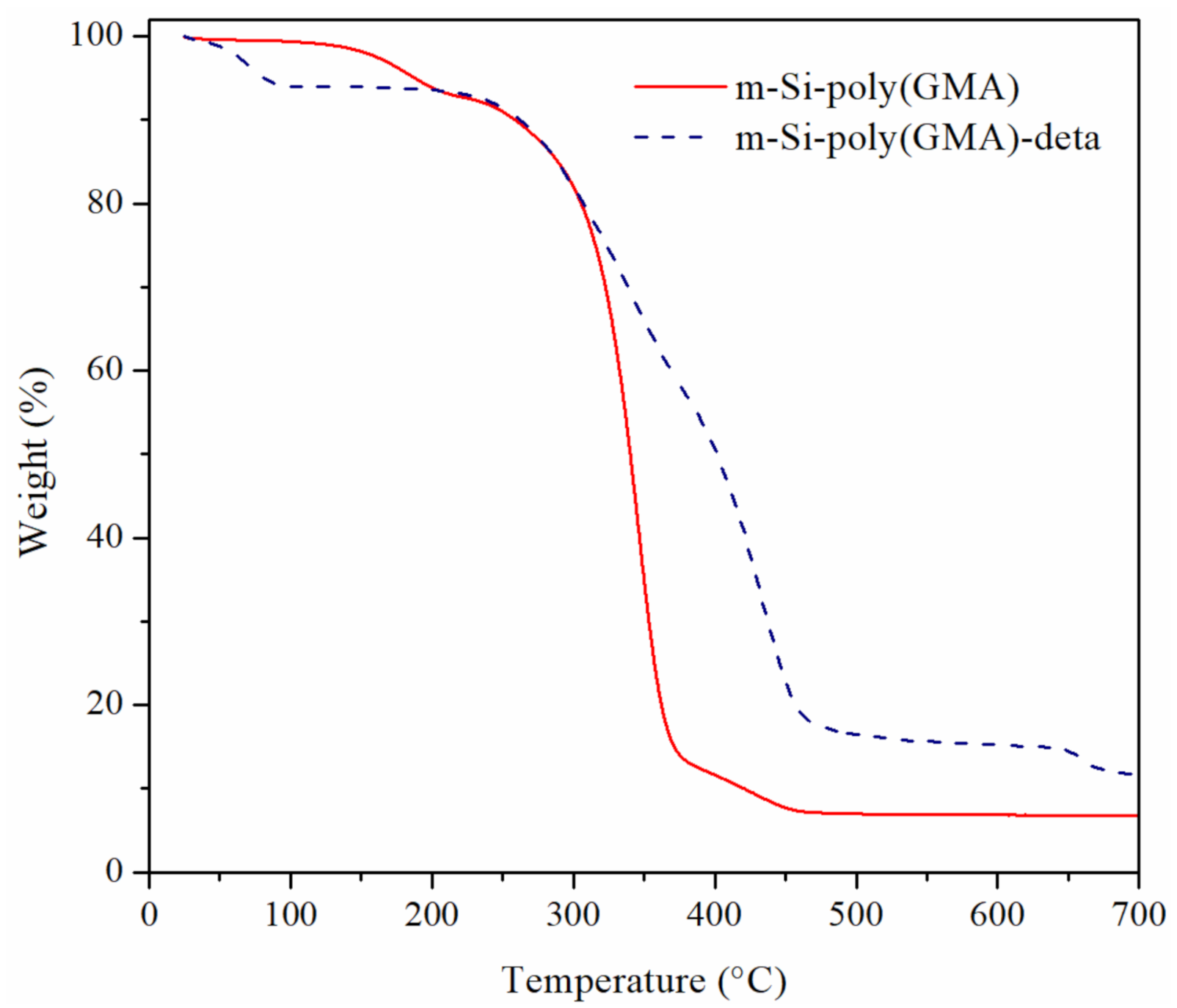
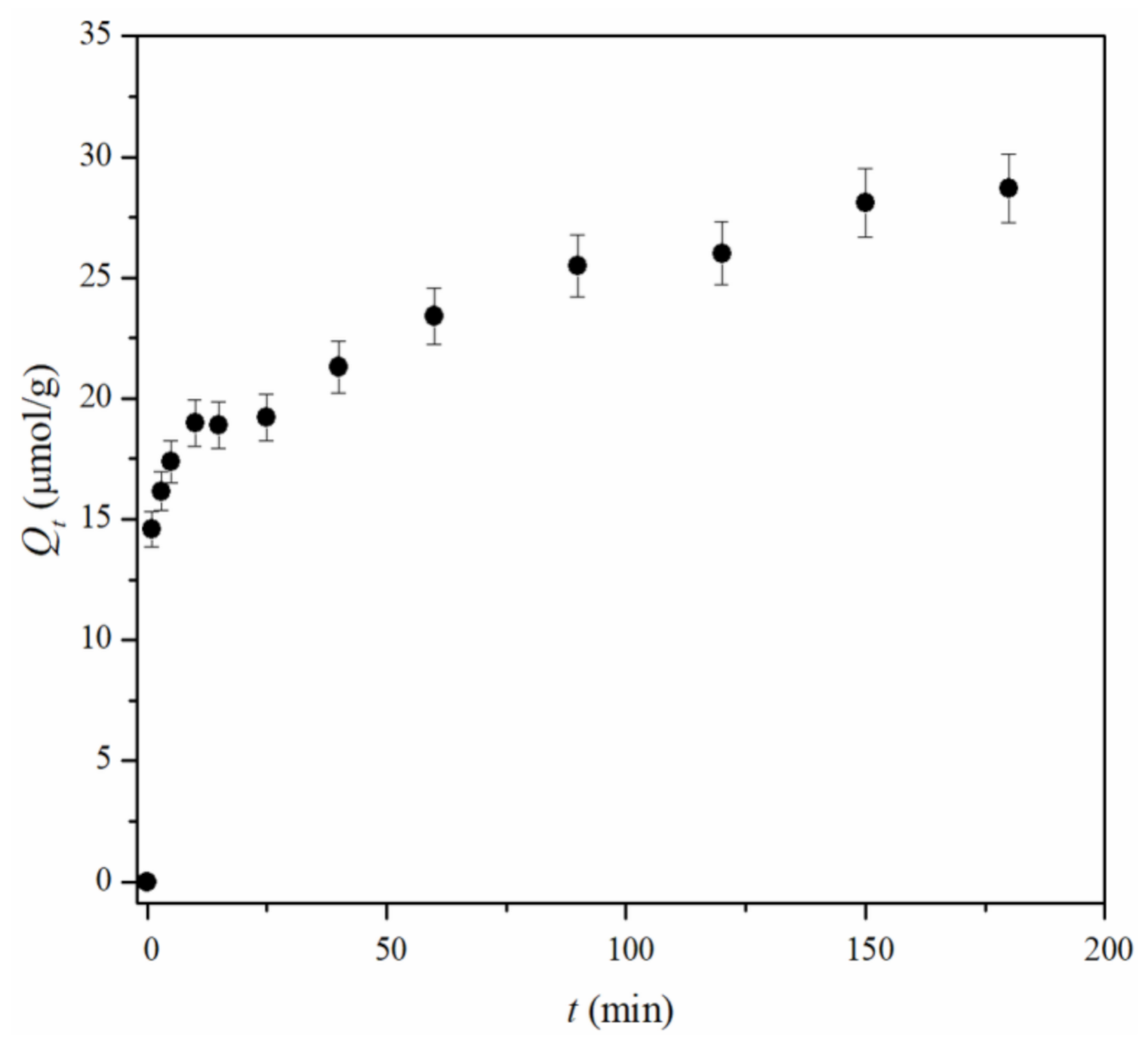


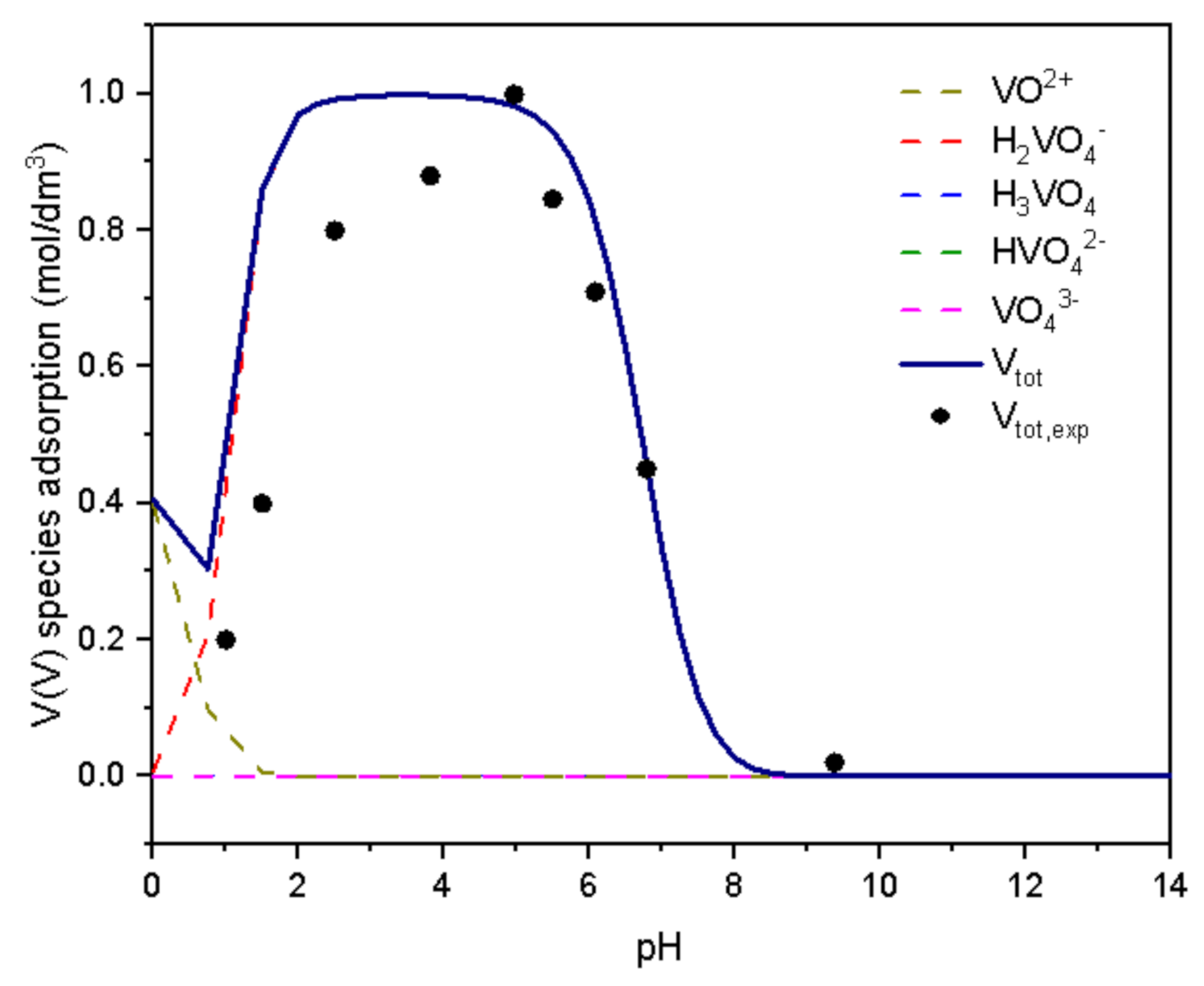
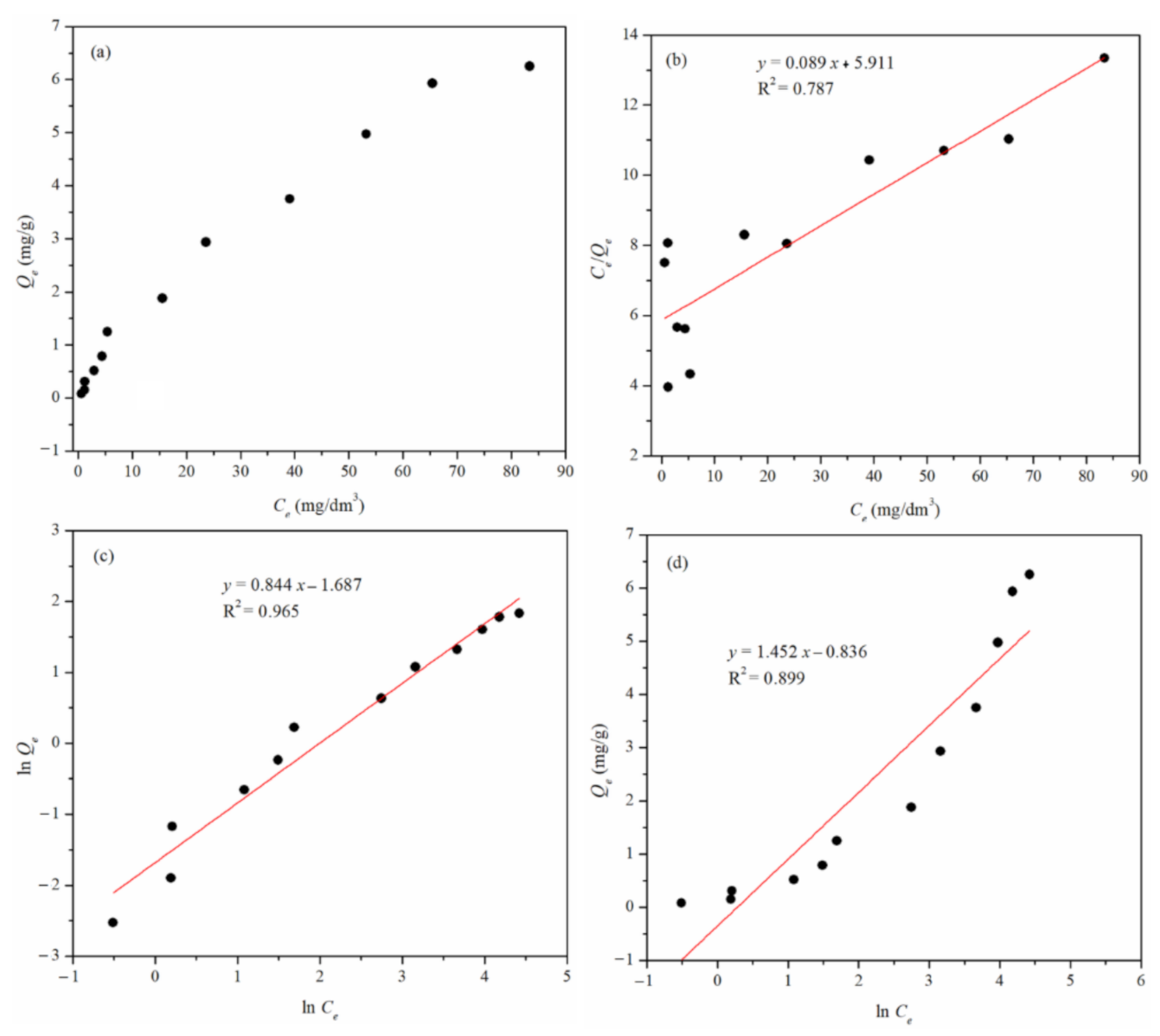
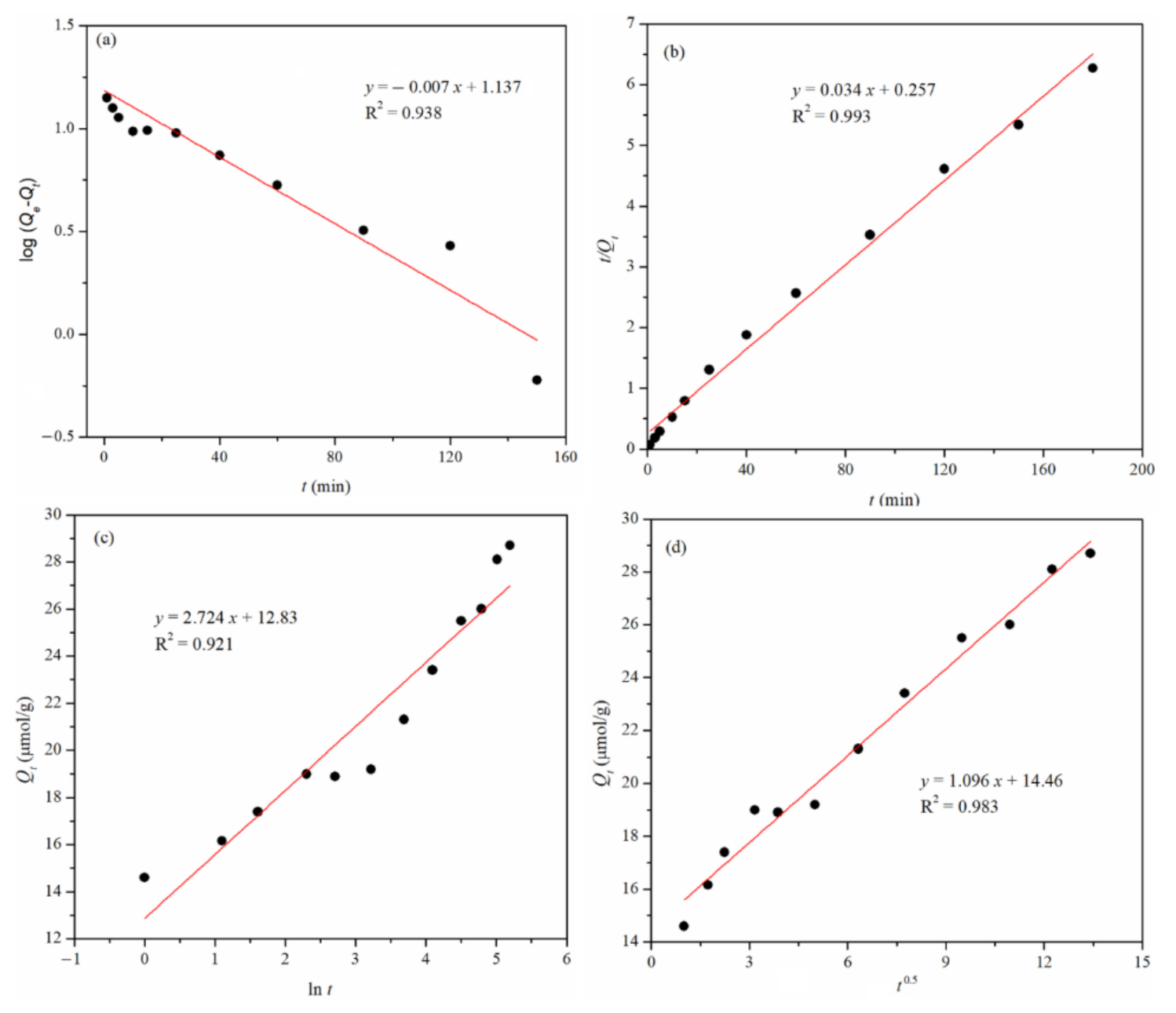
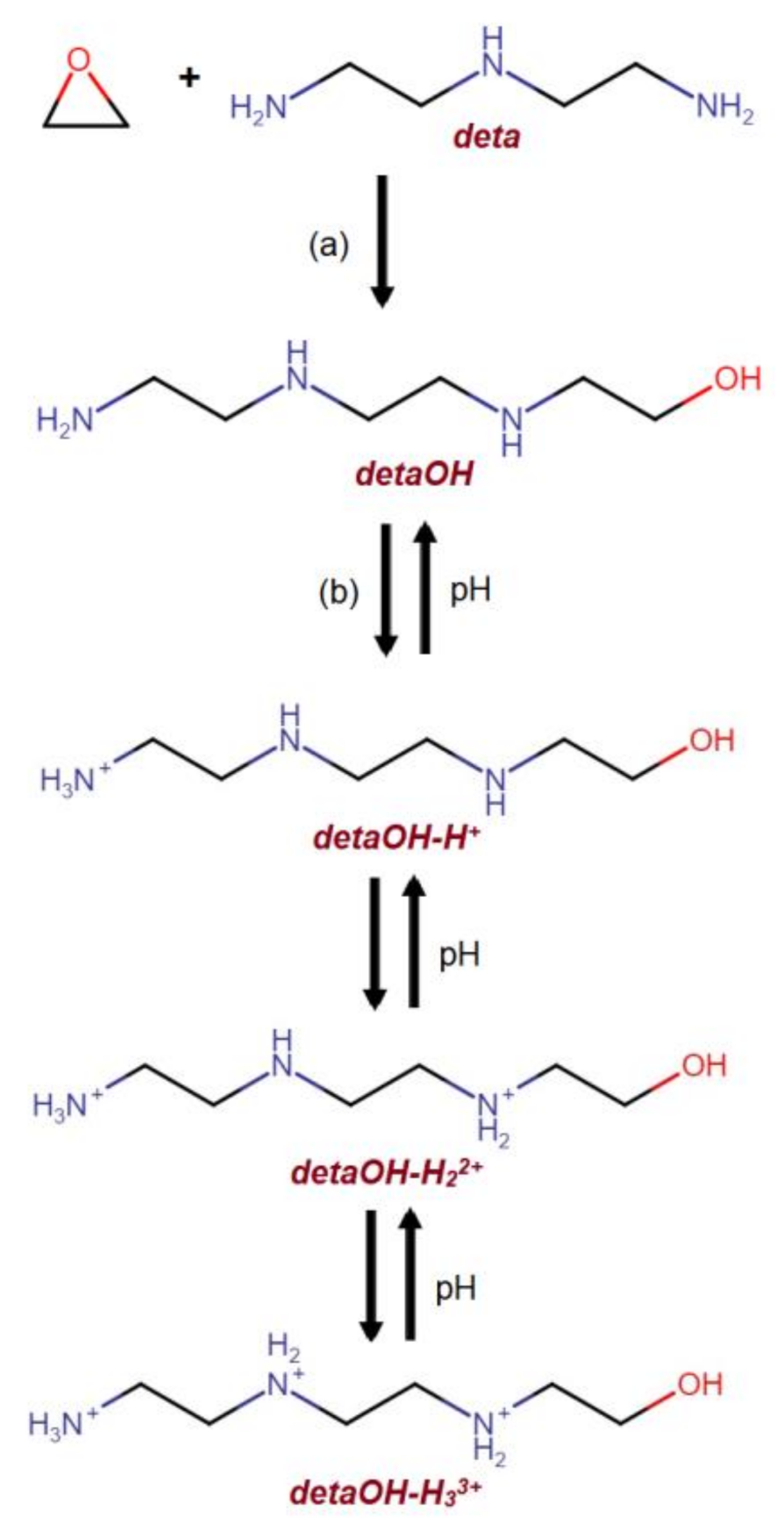

| Sample | Vs, cm3/g | Ss,Hg, m2/g | DV/2, nm |
|---|---|---|---|
| m-poly(GME) * | 1.08 | 67 | 100 |
| m-Si-poly(GME) | 1.32 | 32 | 272 |
| m-poly(GME)-deta * | 0.99 | 59 | 104 |
| m-Si-poly(GME)-deta | 1.20 | 37 | 286 |
| Sample | Degradation Steps, T (°C) | Tmax (°C) | T5% (°C) | T10% (°C) | T50% (°C) | ||
|---|---|---|---|---|---|---|---|
| I | II | III | |||||
| m-Si-poly(GME) | 30–220 | 220–400 | 400–470 | 182/347/430 | 187 | 260 | 342 |
| m-Si-poly(GME)-deta | 30–100 | 100–370 | 370–560 | 70/342/430 | 83 | 260 | 400 |
| Isotherm Models | Parameters | V(V) |
|---|---|---|
| Langmuir | Qmax (mg/g) | 11.23 |
| KL (1/mg·dm) | 0.015 | |
| RL | 0.0067 | |
| R2 | 0.79 | |
| Freundlich | nf | 1.18 |
| KF (mg/g)(mg/L)1/n | 0.18 | |
| R2 | 0.96 | |
| Tempkin | AT (dm3/mg) | 0.56 |
| bT (kJ/mg) | 1.71 | |
| R2 | 0.90 |
| PFO | |||
| k1 1/min | Qe µmol/g | R2 | |
| 0.016 | 13.7 | 0.938 | |
| PSO | |||
| k2 g/(µmol·min) | Qe µmol/g | h µmol/(g·min) | R2 |
| 0.0045 | 29.41 | 3.89 | 0.993 |
| Elovich | |||
| ae µmol/(g·min) | be g/µmol | R2 | |
| 302.5 | 0.37 | 0.921 | |
| IPD | |||
| kid (µmol/g)·min−0..5 | Cid µmol/g | R2 | |
| 1.10 | 14.5 | 0.983 | |
| Starting Geometry | Optimized Geometry | Abbreviation of Dimer | Interaction Energy |
|---|---|---|---|
| detaOH-H33+…H3VO4 | detaOH-H33+…H3VO4 | D3-V0 | −55.9 |
| detaOH-H33+…H2VO4− | detaOH-H33+…H2VO4− | D3-V1 | −311.6 |
| detaOH-H22+…H2VO4− | detaOH-H22+…H2VO4− | D2-V1 | −203.4 |
| detaOH-H22+…HVO42− | detaOH…H3VO4 | D0-V0 | −44.8 |
Publisher’s Note: MDPI stays neutral with regard to jurisdictional claims in published maps and institutional affiliations. |
© 2021 by the authors. Licensee MDPI, Basel, Switzerland. This article is an open access article distributed under the terms and conditions of the Creative Commons Attribution (CC BY) license (https://creativecommons.org/licenses/by/4.0/).
Share and Cite
Suručić, L.; Tadić, T.; Janjić, G.; Marković, B.; Nastasović, A.; Onjia, A. Recovery of Vanadium (V) Oxyanions by a Magnetic Macroporous Copolymer Nanocomposite Sorbent. Metals 2021, 11, 1777. https://doi.org/10.3390/met11111777
Suručić L, Tadić T, Janjić G, Marković B, Nastasović A, Onjia A. Recovery of Vanadium (V) Oxyanions by a Magnetic Macroporous Copolymer Nanocomposite Sorbent. Metals. 2021; 11(11):1777. https://doi.org/10.3390/met11111777
Chicago/Turabian StyleSuručić, Ljiljana, Tamara Tadić, Goran Janjić, Bojana Marković, Aleksandra Nastasović, and Antonije Onjia. 2021. "Recovery of Vanadium (V) Oxyanions by a Magnetic Macroporous Copolymer Nanocomposite Sorbent" Metals 11, no. 11: 1777. https://doi.org/10.3390/met11111777






